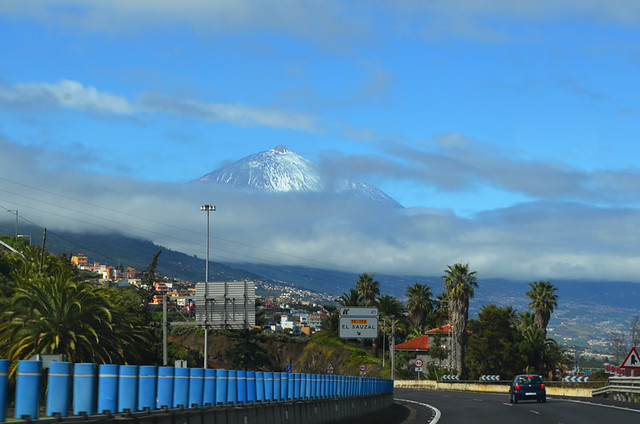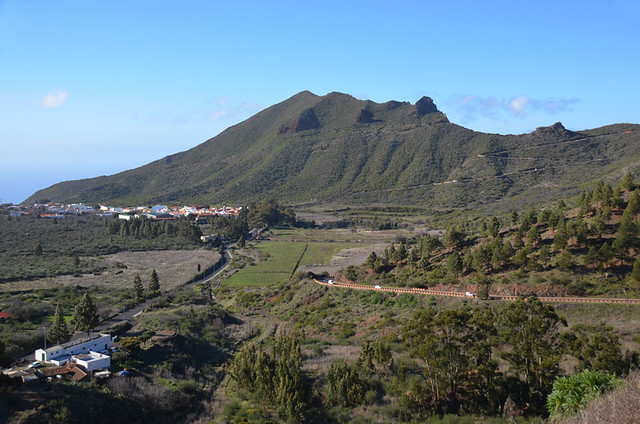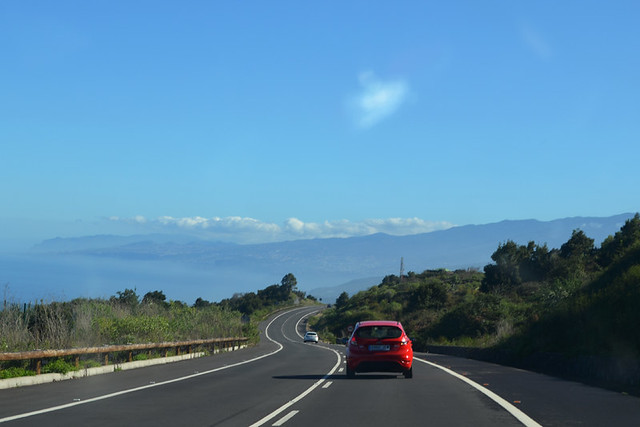What is the best way to drive from the south of Tenerife to the north of Tenerife?
There are a number of routes from south to north or vice versa. But in this instance I’ll stick to the two quickest routes to get from Tenerife South Airport to Puerto de la Cruz; heading east via La Laguna and heading west via Santiago del Teide. In theory there’s not a lot to separate them. At the time of writing (10am on a Wednesday) Google Directions informs me that via La Laguna the journey will take one hour and two minutes, whilst heading west it’ll take one hour and nineteen minutes. This estimate will change depending on the time of day, so shouldn’t be taken as being set in concrete otherwise some folk will be in for a huge shock.

Driving south to north heading east via La Laguna
It’s motorway, or Tenerife’s equivalent of a motorway, all the way. You head east on the TF1 toward Santa Cruz, change to the TF2 at Santa Maria del Mar to turn north, and then merge with the TF5 at La Laguna before travelling west to Puerto de la Cruz.

The first time we drove that way we picked up the hire car after dark to join a motorway which was surprisingly dimly lit. The stretch to the TF2 exit was straightforward, but we were nearly caught out by the length of the queue leaving the TF1 at Santa Maria del Mar. The slip road has been extended since, and the link to the TF2 improved. So, although there’s still a queue at peak commuting times, it moves a lot faster than it once did. Then we were surprised by the steepness of the climb to reach the TF5.

The road takes you past the business park where Decathlon, Ikea etc. are located so the final section is often quite busy, meaning you can queue to join the TF5. It’s essential to get into the left lane early, to ensure you’re in the right position to descend through the tunnel which curves to eventually merge with the TF5. Next surprise is the fact that the TF5 at La Laguna has four lanes, with cars criss-crossing all four. Drivers stay in the quieter outside lanes till the last moment before veering inwards to get to the La Laguna exit they want. The best approach is to get to the outside lane as quickly as possible, otherwise you can get trapped by the La Laguna traffic. First couple of times it can be a nerve-wracking experience, especially in an unfamiliar hire car. Once you’re used to it, it’s not so manic.

The traffic remains relatively heavy until you pass Tacoronte. From there it thins out and stays like that all the way to Puerto de la Cruz… unless there’s been an accident at El Sauzal. The corner at El Sauzal was once the traffic accident black spot of the island – locals took it far too fast. Now there’s a lower speed limit on this corner and accidents have been reduced significantly.
Google’s estimated time of just over an hour for this route is at a quiet time for traffic. However, you can add on a significant amount of extra time if driving this way during rush hour/s. At these times you’ll hit heavy traffic on the Laguna stretch and, if driving north to south early morning, you could find yourself sitting in a queue for hours. The longest drive time it took us from Puerto de la Cruz to the south airport was three hours. There were no accidents, it was simply volume of traffic.

The pros: It’s motorway all the way. It’s well signposted. It’s a quick route outside of peak commuting times. And you get the most fabulous views of Mount Teide when the weather is clear.
The cons: Sections can heavily congested with traffic meaning journeys might take far longer than expected. Some people could find switching from TF1 to TF2 to TF5 problematic.

Driving south to north heading west via Santiago del Teide
The first time we drove to Puerto de la Cruz from Los Gigantes (in 2002) there wasn’t even tarmac on the stretch at Ruigomez, and we bumped along a hard, red earth road for a few kilometres. That was only temporary, but it was never a quick route. A scenic and interesting one yes (we include it in our Real Tenerife Driving routes), but using it get from north to south in a hurry was invariably frustrating; there was always something slow moving in front to impede progress and, as the road is mostly a winding one, there are only a couple of overtaking opportunities. Even knowing when these were coming, as well as where there were shortcuts, didn’t make it a quick option.

The construction of the Anillo Insular (basically a ring road) has been a game-changer. Currently it connects Santiago del Teide with Costa Adeje, meaning drivers can stay on the TFI motorway all the way from the airport to the western hill town. It’s quick and quiet, once you break free from the resort areas. At Santiago del Teide, progress north requires taking to the old TF82 for 14km until El Tanque. This stretch is winding and can be slow, but it is pretty. Completing the final section of the Anillo Insular, linking Santiago with El Tanque, has become entrenched in the mud over the last couple of years. But an injection of Canary Islands Government cash was announced in May 2019, so the final stretch has been given the green light… again. Don’t hold your breath. The reason why it’s the last section to be completed is, although only just over 11km long, it’s the most difficult section as it will involve tunnelling through the Teno Massif. When finished, the tunnel will be one of the longest in Spain. The estimated time for completion is five years. Vamos a ver, as they say in Spain.

At El Tanque the wide and fast Anillo Insular starts again, signposted as being the TF5. It initially climbs over the hills before descending spectacularly to reach the coast at Buen Paso. Any time we’ve driven this route there have been only a handful of other cars on the road. I’ve seen in described as both being dangerous and winding. I’d dispute both of these. In fact it’s a description which perplexes me. We love this section, it’s a joy to drive. At Buen Paso, the coastal road heads east to Puerto de la Cruz. It’s another great stretch of road which is both relatively fast moving and scenic.

The Pros: It’s mostly as quick, if not quicker, than heading east. It’s a scenic route through an ever-changing countryside. It’s usually not busy with other traffic. There are no built up urban areas.
The cons: The stretch linking Santiago del Teide with El Tanque can be slow and off-putting to anyone who is uncomfortable driving on winding roads.

Different people will have differing views. Which way is best (quickest) depends on where anyone’s starting/end point is both north and south. However, after the Anillo Insular opened, we completely dumped the via La Laguna route as a way of heading south.




On the relatively few times I have had to negotiate it, I’ve found that leaving the TF1 for the TF2 was very easy to miss. My memory is hazy but I don’t recall it being particularly well signposted – at least for tourists. I was probably looking for a sign to Puerto de la Cruz and may not have seen one. Almost as bad is the reverse direction getting onto the TF2 from the TF5 which, in my memory, comes at one sooner and quicker than one realises along with a sudden need to cross 3 lanes of traffic!
That’s partly why I added a ‘con’ about changing motorways being potentially problematic. In theory it should be relatively straightforward, but until you’ve done it a few times parts are confusing – a case of you have to already know where the signs are. On La Palma there are places where the signs to towns are located immediately after the slip road 🙂
Hi I planing on a 7 days trip with my husband to Tenerife south
We are coming from Miami Florida USA
Can you help me with safes way to know the island and best restaurants
Planing to go to the North
Thank you Maria
Just had a look at google maps out of curiosity about the signs. It does show a spectacular line of cars that extends back past at least two entrance ramps. I can easily see that line deterring the uncertain driver. And, as far as I could tell, the only sign for La Laguna comes after the last possible point for entering the TF2. I may not have gone back far enough up the road but I did start a fair ways back.
And that’s the improved layout 🙂 Before that the queue backed up along the motorway – it was seriously dangerous. I always sighed with relief we we made it onto the relative safety of the slip road without being squashed by a truck. We’ve long felt that in the Canaries there can be an element of ‘everybody knows about it so no need to change’ about a variety of things.
Perfect description Jack, having driven both ways many years, I personally think the Santiago del Tiede route is by far the better route. The TF-82 from Santiago to El Tanque can be daunting the first time around because of the winding road, simply take your time, don’t be rushed, and once you’ve done once you’ll be fine. Coupled with the fact that this route has stunning views, it’s beautiful!